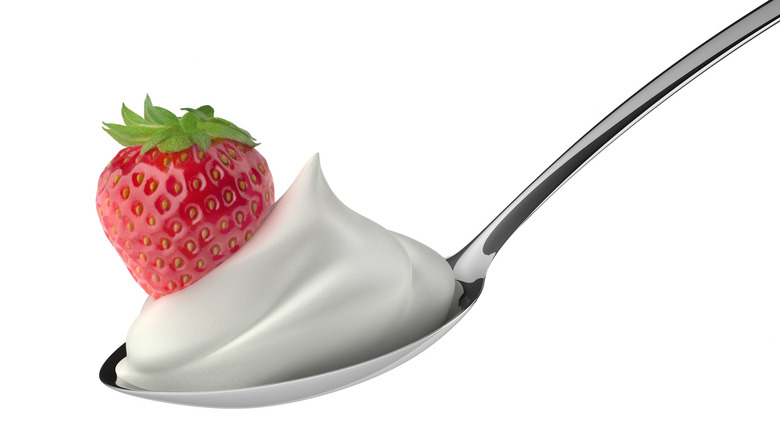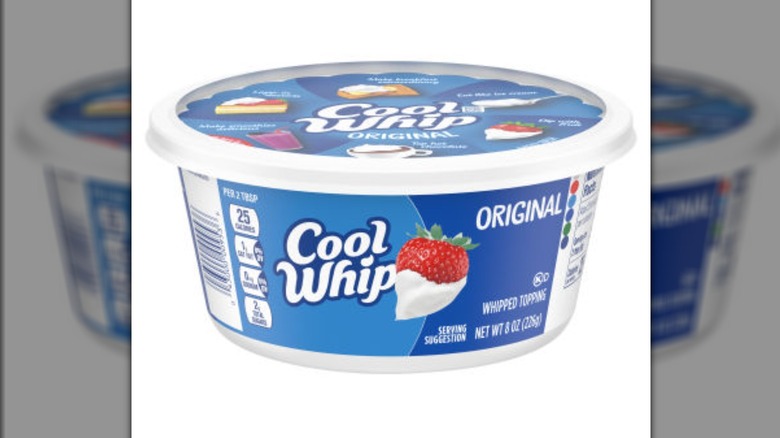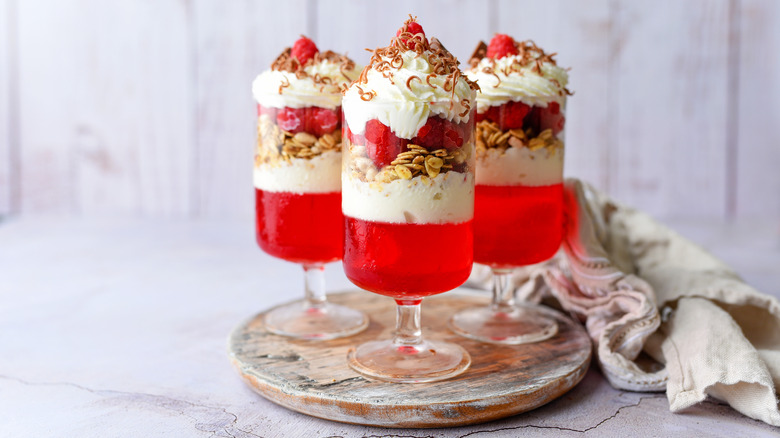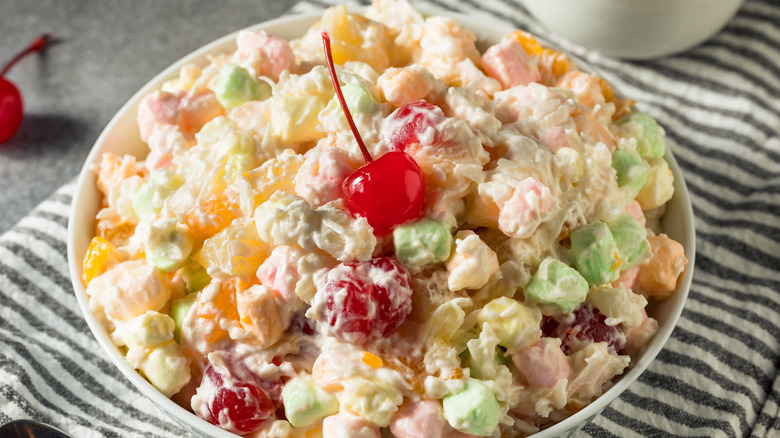This Is How Cool Whip Is Really Made
For more than half a century, Cool Whip has been a part of the American culinary discussion, a retro treat that has managed to remain popular in modern times. It's the backbone of many a dessert, and if you're from the Midwest, it's an integral part of "salads."
But what exactly is Cool Whip, and how is it made? For starters, Cool Whip is not whipped cream, both in the physical sense and the legal sense. The FDA considers Cool Whip a non-dairy product, and it has been sold as such since it was introduced in 1966. Originally, it contained no dairy products at all, although today it contains a small amount of skim milk, light cream, and sodium caseinate derived from milk.
Cool Whip is made by combining a whole bunch of things — namely water and skim milk, hydrogenated vegetable oil (from coconut and palm kernels), high fructose corn syrup, natural and artificial flavors, and emulsifiers like xantham gum and guar gum. There are 16 ingredients in total in Cool Whip, and all come together to make the sturdy, fluffy dessert topping that graces grocery store freezers and home refrigerators across the country.
The birth of Cool Whip
Cool Whip is the brainchild of William A. Mitchell, who was a chemist at General Mills in the mid part of the 20th century. Mitchell was looking to devise a substitute for traditional whipped cream that not only saved the home cook time but was also stable enough to be shipped around the country and not deteriorate as quickly as whipped cream. (Mitchell was also the force behind Jell-O, Pop Rocks, and Tang, among other edible inventions.)
Over the years, it has grown from the original flavor to include spin-offs like Light, Extra Creamy, and even one-off seasonal flavors like Peppermint and Cheesecake. All iterations of Cool Whip still come in that distinctive round plastic tub.
The debate over whether or not Cool Whip is actually good for you also rages on today. There are some who say you should think twice before buying Cool Whip, mainly because of the hydrogenated oils and high-fructose corn syrup that it contains. For others, it's a nostalgic and irreplaceable part of their food history. In the Midwest, where the term "salad" is perhaps a bit looser than what many believe a salad to be, Cool Whip is an integral part of classic dishes like Strawberry Salad.
How to cook with Cool Whip
If you fall firmly on the side of Team Cool Whip, the good news is that there are plenty of ways you can use up the whole tub of the whipped creation. By the simple fact that it's been a ubiquitous presence in the American Food scene for generations, there are tons of recipes out there that use Cool Whip in ways both expected and surprising.
Wendy's fans will be glad to know that Cool Whip is a key component of this easy 3-ingredient copycat Frosty recipe. You could honor two of Mitchell's inventions and make this easy Jell-o parfait recipe that also uses Cool Whip. If you like your desserts with a hint of lemon, try this easy Cool Whip cookie recipe, or be the hero of any summer cookout with this easy banana cream pie recipe.
If you're from the Southwest then you might already be familiar with Frog Eye Salad. A staple adorning countless Thanksgiving tables, it's made with pasta, mini marshmallows, canned fruit, and, you guessed it, Cool Whip.
If for some reason you want that Cool Whip-like texture and taste but want to avoid the actual product itself (either because you can't eat dairy or are turned off by the long list of industrial ingredients), don't worry. We've got a few things that you can substitute for Cool Whip, including how to make a vegan-friendly swap!
Cool Whip is here to stay
Cool Whip's history is one of those uniquely American stories. Innovation met the mid-century craze for convenience, and one of the most iconic foods of the last few generations was born. For 57 years, it's been a staple in kitchens across the country — even the tubs themselves have taken on their own life as containers for leftovers and knick-knacks in many households.
Despite its "love it or hate it" reputation, and some questionable ingredients, Cool Whip continues to delight (or maybe disgust) consumers everywhere. It's even become known as a unique hack for making a marbled effect on Easter eggs!
It's impossible to know if Mr. Mitchell understood what an out-sized role he was going to play in America's food scene when he invented Cool Whip all those years ago at General Mills, but it's safe to say that Cool Whip probably isn't going anywhere soon. It may never replace true whipped cream, but it's hard to imagine a nostalgic, mid-century-inspired treat without it.



